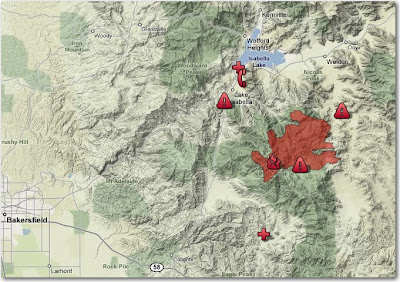Reporters for the Mercury News in Silicon Valley in California reviewed Incident Status Summary forms, ICS-209’s, from many of the California fires and harvested narrative comments from the forms regarding the availability of resources. The entire article is worth reading, but here are a few excerpts:
“A shortage of equipment and manpower has contributed to the spread of fires across the state, according to frustrated fire commanders trying to subdue the state’s 320 raging wildland blazes.
Internal reports from experts out in the field reveal repeated requests for additional help – and concern for their firefighters’ lives.
“All fires on the Complex are minimally staffed . . . Due to limited resources, there are some divisions unstaffed,” according to an incident status summary by Ron Roberts at the Shasta and Trinity County fire, the site of 34 injuries. “Operational adjustments have been made due to the lack of resources.”
In Kern County’s Piute Fire, commander Chris Hoff asked repeatedly for more officers, writing “Lack of overhead positions continue to hamper suppression efforts.” In a Humboldt County fire, called Hell’s Half Complex, commander Jess Secrest wrote that “Continued inability to fill critical resource orders increases the fire’s ability to enter residential areas, expected later this week.”
More than 700,000 acres have burned – and 99 homes lost – since a series of wildfires scorched the state. The destruction – particularly the expansion of a blaze into several Shasta-based towns – prompted the governor to deploy the state’s National Guard, the first time in 31 years.
On Thursday afternoon, secretary of the Homeland Security Michael Chertoff promised to provide federal helicopters to dump water. He also said he would send out-of-state fire fighters to train incoming National Guardsmen.”
[…]
“The National Multi-Agency Coordinating Group, which supervises staffing of the nation’s fires, has issued a report warning that California’s needs were “stretching the national response capability.”
“The situation in California, particularly the northern part of the state, is perhaps unprecedented and the needs for crews, aircraft, equipment and support are already acute,” it said. The group cautioned that “The rate of ‘unable to fill’ orders is increasing.”
Documents called “incident status summaries,” submitted by on-site commanders to U.S. Forestry Service and Cal Fire authorities, show repeated requests for help.
In the Canyon Fire, in Plumas County, two blazes have been reduced to “patrol status,” with no one to fight them, according to Commander Jeanne Pincha-Tulley. She wrote: “Lack of sufficient suppression resources, especially hand crews. . .Multiple crews are reaching their maximum work assignment. . .This reduction in resources may affect the predicted containment date and strategies if replacement crews are not assigned.”
At Hell’s Half Complex, “fire growth has continued. . .five fewer crews being available to work today’s shift.”
The number of concerns written into official reports signals how extreme the situation has become, some said.
[…]
An estimated 84 wildfires in California are burning “unstaffed,” according to the national coordinating group, “and have the potential to burn through much of the summer and into the fall until rainfall increases.”
============================
Meanwhile, Governor Schwarzenegger today sent a letter to President Bush requesting help with the fires in California. Some of his requests include:
- Federal active duty forces to provide additional Type II firefighting handcrews to meet shortages;
- Additional out-of-state federal firefighters to provide training for National Guard personnel as Type II handcrews;
- Increasing the “Maximum Efficiency Level” (MEL) for the U.S. Forest Service to 100 percent.
=============================
I wonder if the federal bean counters are still being assigned to all the large fires with the mission of nagging Incident Commanders to fight fire on the cheap?
=============================
Today the U.S. Forest Service sent out their almost-annual “let my people go” letter, reminding managers that:
Our foundation principles guide us to support local fire emergencies as a priority over resource targets. Non-local fire emergencies can be supported at the local line officer’s discretion…. Line officers must support these fire suppression efforts and ensure employees are available to support the current national response to wildfires.”
Sometimes the letter is referred to as “The Moses Letter”.
And afterward Moses and Aaron went in, and told Pharaoh, Thus saith the Lord God of Israel, Let my people go, that they may hold a feast unto me in the wilderness.
— Exodus 5: 1 (KJV)





